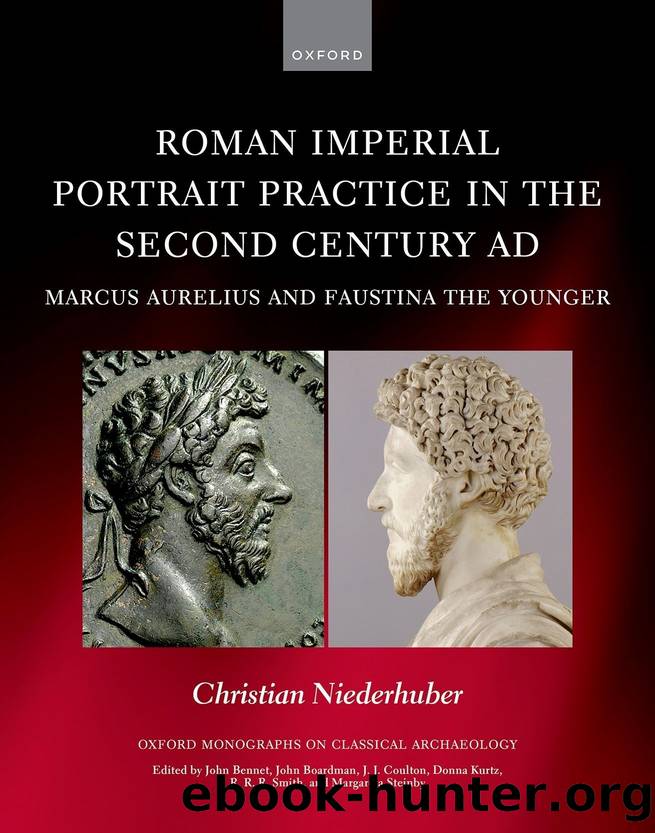Roman Imperial Portrait Practice in the Second Century AD by Niederhuber Christian;

Author:Niederhuber, Christian; [Niederhuber, Christian]
Language: eng
Format: epub
Publisher: Oxford University Press USA - OSO
Published: 2022-06-11T00:00:00+00:00
Coins and medallions of ad 139â144 (COS DES and COS)âaged 18â23
The earliest imperial coins with the portrait of Marcus Aurelius on the reverse, the joint issue with Antoninus Pius that was minted in late ad 139 (COS DES) (Fig. 123) and continued in ad 140 (COS) and probably later (Fig. 124), show the prince as a youth with a rounded face and lavish large, protruding curls, deeply engraved on the dies. Frequently, short strands and stray hair, indicated by more shallow incisions, escape the contour of the hair and enliven the flamboyant hairstyle (Fig. 125). The same issues, however, already also show the prince from ad 139 onwards with a more elongated face and a more pronounced chin, best observed on the (in comparison to other denominations) more frequent denarii (Fig. 126). The hairstyle of this more mature portrait does not distinctively change but the contour of the hair appears on some dies to be slightly more uniform (Fig. 127).15
The more mature version of the portrait of the prince continues, with some exceptions, from ad 140 to 144 (COS) on the imperial coins in Marcus Aureliusâ own name with his likeness on the obverse. It has already been observed in previous studies that most of the dies of this period show him still beardless (Figs. 128â9), but some of the latest coin portraits already feature, to a variable degree, a faint beard on the cheeks, the chin, and the upper lip (Fig. 130).16 More precision can be reached here: the years from ad 140 to 144 (COS) feature three main reverse types. No facial hair appears on portraits that are connected with the reverse type âPietas Augâ, which is probably the inaugurative type for the prince, as the occasionally still very youthful physiognomy also suggests (Fig. 131). A faint beard rarely occurs in connection with the reverse type âIuventasâ (Fig. 132) but is frequently found on portraits connected with the reverse type âHonosâ (Fig. 130); the iconography of the latter reverse type is carried on into the COS DES II and COS II issues. Clearly, H. Mattingly was right when he suggested that these three reverse types are successive.17
The more mature portrait also appears on the medallions from ad 140â4 (COS), both on the joint issue(s) with Antoninus Pius (Fig. 133) and on the medallions in Marcusâ own name (Fig. 134). All of the pieces published by Gnecchi appear to be beardless.18
Marked (dotted) pupils, giving âlifeâ to the portrait, begin to emerge ad 139â40 and they are soon commonplace on the coins and medallions of Marcus Aurelius.19
Download
This site does not store any files on its server. We only index and link to content provided by other sites. Please contact the content providers to delete copyright contents if any and email us, we'll remove relevant links or contents immediately.
Picasso by Gertrude Stein(1452)
Modeling the Head in Clay by Bruno Lucchesi(1429)
Auguste Rodin by Rainer Maria Rilke(1291)
Modelling and Sculpture by Albert Toft(1218)
The Parthenon Marbles by Christopher Hitchens(1102)
Louise Nevelson by Laurie Wilson(1100)
You Must Change Your Life by Rachel Corbett(1074)
Antony Gormley on Sculpture by Antony Gormley(1070)
Asmat Art by Dirk Smidt(1058)
The TAB Guide to DIY Welding : Hands-on Projects for Hobbyists, Handymen, and Artists by Jackson Morley(1040)
Greek Art by John Boardman(1032)
Modular Origami Polyhedra by Lewis Simon & Bennett Arnstein & Rona Gurkewitz(1017)
Origami Holiday Decorations by Florence Temko(964)
Origami for Beginners by Florence Temko(961)
Spiral Jetta: A Road Trip through the Land Art of the American West (Culture Trails) by Erin Hogan(936)
The Animal Gazer by Edgardo Franzosini(932)
The Autobiography of Benvenuto Cellini (Penguin Classics) by Benvenuto Cellini(917)
The Pagan's Cup by Fergus Hume(910)
Metal Clay Jewelry: Projects. Techniques. Inspirations. by Louise Duhamel(904)
